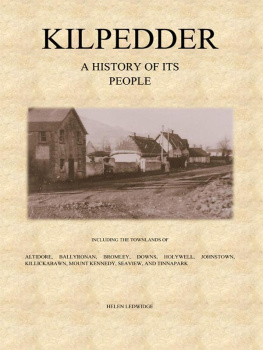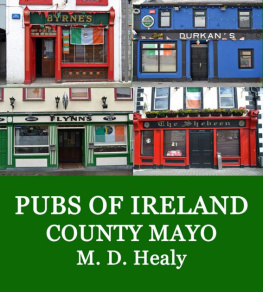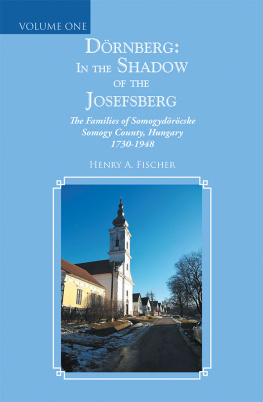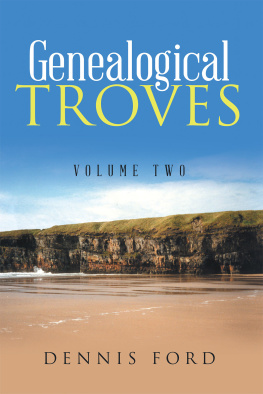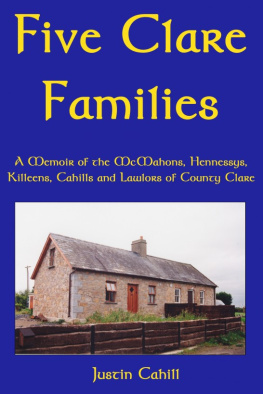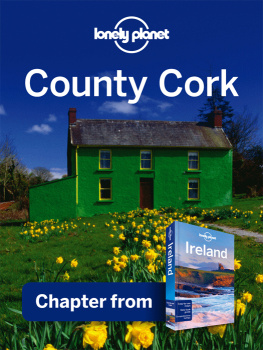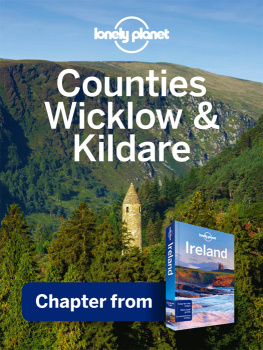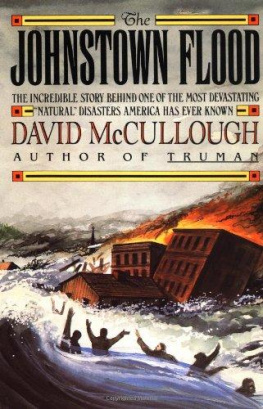All rights reserved. No part of this publication may be reproduced in any form or by any meansgraphic, electronic or mechanical, including photocopying, recording, taping or information storage and retrieval systemswithout the prior written permission of the author.
Published by ORIGINAL WRITING LTD., Dublin, 2011.
INTRODUCTION
Kilpedder has been my home for over 20 years, it is a small quiet village sparsely populated and surrounded by beautiful countryside in the Garden of Ireland County Wicklow. As a genealogist, I was curious about the lives of people who lived in Kilpedder long ago, I knew very little about the area and I wanted to find out more, I soon realised that the history of Kilpedder had been sadly neglected as only a limited amount of information had been set down in writing about the area.
I started researching and writing the history of the area, concentrating on the genealogical history of selected families who lived in the townland. I found it was necessary to include the history of selected families from ten surrounding townlands, as geographically the ten townlands are all within a two-mile radius of Kilpedder village and some occupants were closely interrelated or linked by marriage. The surrounding townlands are, Altidore, Ballyronan, Bromley, Downs, Holywell, Johnstown, Killickabawn, Mount Kennedy, Seaview, and Tinnapark.
The book gives a genealogical history of selected landowners and tenants I have tried to include as many families as possible. The information compiled will be valuable for persons interested in local history, or researching their ancestors in the townlands covered. I have included a surname database transcribed from local parish records, cemeteries, hearth money rolls, manuscripts, election registers, cancelled valuations, Griffith Valuations, land records, 1901/1911 census records, Irish Times Newspaper Archive articles, and much more.
I have spent many happy hours compiling evidence of my by-gone neighbours, trawling through the records of archives and libraries, walking around cemeteries in all weather conditions, transcribing and inspecting gravestones. I walked and drove up and down every highway and byway in the area, taking photographs and interviewing locals. I enjoyed chatting with so many friendly neighbours who recalled their memories of Kilpedder in olden days.
I want to thank my neighbours; Philip Emmet, Paddy Lenehan, Rhoda Massey, Ellen Mahoney, Rose, Dick and Risin O Toole, Ane Hofmann, Bobby and Mary Evans, Kevin and Audrey Whelan, Peter O Neill, David and Betty Kelly and Liam Kelly.
Many interesting characters have left their footprints on the locality, Kilpedder and the townlands that border it are indeed steeped in history dating back to pre- Christian times.

Kilpedder circa 1947

Kilpedder 2010
KILPEDDER COUNTY WICKLOW

EARLY OCCUPIERS
In March 1944, a local farmer Richard Brady was ploughing a field at a disused quarry at Tinnapark demesne near Kilpedder. He discovered a stone-lined grave lying a few centimetres below the surface on the side of a low hill, with its side stones partially sunk in the gravel of the hillside. When the capstones were removed a skeleton was discovered lying on its back resting on the gravel, the arms were placed beside the body and the legs extended the full length of the grave, some of the cap stones had slipped into the grave breaking the skull and other parts of the skeleton.
A representative from the National Museum, Mr. Joseph Raftery visited the site and he reported that the grave was found in the field known as Synnotts Field. The field beside it is called the Crow Field which might be connected with Cro, a Hut where a bullaun stone of granite was found indicating an ancient settlement within a quarter of a mile of the burial. A bullaun is a deep hemispherical cup hollowed out of a rock, many were found in association with early churches and holy wells, later this bullaun stone was moved to the garden of Tinnapark house, and there is no evidence as to the date of this settlement.

Photograph of the Long Stone Cist found at Tinnapark 1944 (Royal Society of Antiquarians)
Mr. Raftery wrote; that in his opinion the Tinnapark Long Stone Cist conforms to the normal Long Stone Cist type and it is customary to accept that the vast majority must belong to pre-Christian Iron Age The closest parallels occur in Scotland and Norway, where they are dated in the first four centuries of our era, a similar dating for Tinnapark may be assumed. During ploughing and quarrying work in 1944, 1963 and 1964, seven long cists with human remains of adults were found at Tinnapark. It is probable that there was a settlement in the surrounding area dating back to pre-Christian times.

Sugarloaf Mountain

Mount Kennedy Estate

View towards Kilpedder, Downshill and the Sugarloaf Mountain

Townlands map
Kilpedder in County Wicklow is set amongst some of the most beautiful scenery in the country, between the picturesque Glen of the Downs and Newtownmountkennedy. Situated off the main road from Dublin to Wexford, a duel-carriageway divides the townland into Kilpedder East and Kilpedder West. The townlands of Altidore, Ballyronan, Bromley, Downs, Holywell, Johnstown, Killickabawn, Mount Kennedy, Seaview, and Tinnapark are within a two-mile radius of the village.
All to one side like Kilpedder is a well known saying in County Wicklow, the village consists mainly of a public house, a shop and a number of houses on the west side of the village. Kilpedder east is across a duel- carriageway, where there is a garage and a row of houses built alongside the main road, known locally as Sunnybank. A few hundred yards north of the village on the old Wicklow road, is Johnstown townland where there are a group of cottages, a garage, and several housing estates.
There is an indication from the place name that Kilpedder Cill Pheadair, meaning Peters Church, is a dedication to St. Peter. Liam Price a well-known scholar of Irish history recorded the antiquities, place names and folklore of County Wicklow, suggests in his notebook, that it was an Anglo Norman foundation and may have been the church of nearby Ballyronan Castle, but no evidence of church ruins was found in the area.

